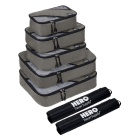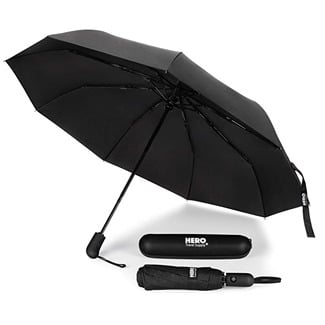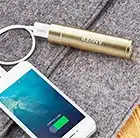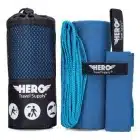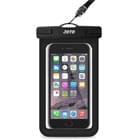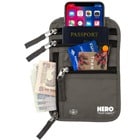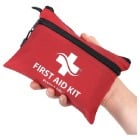Olympic National Park is known for its biodiversity—foggy coastlines, rugged mountains, and the quietest place in the US: Hoh Rainforest. Olympic NP is breathtaking, vast, and incredible. You’ll want to spend every minute that you can in the park. We’ve put together a list of all the things you’ll want to make sure to not forget, what to wear in each season, as well as a list of what NOT to bring.
17 Top Olympic National Park Packing List Items for 2025 + What to Wear & NOT to Bring
What to Pack for Olympic National Park - 17 Essentials
-
1. Backpacking Pack
Whether you need a larger pack or a daypack will depend on your itinerary, but if you’re planning any longer, multi-day hikes, a pack that’s made for treks makes all the difference. The last thing you want is to get to your destination and unsuccessfully try to cram two days of supplies into your daypack. Research backpacking options ahead of time.
![Backpacking Pack]()
-
2. Packing Cubes
When traveling, organization can make the difference between a mildly stressful day and hours of trying to figure out which bag you packed your snacks in. Packing cubes have saved me time, money, and helped keep me sane on trips where there was a lot to keep organized. This set also includes laundry bags so you can keep your dirty and clean clothes separate.
![Hero packing cubes]()
-
3. VPN
If you’re flying out to Olympic National Park or staying at a place with public wi-fi, you’ll want to make sure you have a virtual private network or VPN. You might think you’ll be off the grid, but needing to check secure information unexpectedly while you’re on vacation is part of the fast-paced, digital world we live in. It’s best to be prepared.
![vpn]()
-
4. Bungee Cords
Bungee cords are one of the most versatile, helpful items to have when you’re hiking and backpacking. Their primary use is to hold things that don’t fit in one’s backpack, such as a small tent or bulky coat. Additionally, bungee cords can be used to air dry shoes or whatever you swam in earlier that day. The possibilities are endless!
![Bungee Cords]()
-
5. Windproof Travel Umbrella
Washington State, particularly Seattle and the surrounding areas, are known for rain. Having a windproof, compact umbrella is a must in Olympic National Park. Annual precipitation averages 100-170 inches of rain along the coast and the western-facing valleys. The rain promotes the lush Hoh Rainforest climate that is one of the must-see sights in Olympic NP.
![Windproof Travel Umbrella]()
-
6. Hiking Boots
Sturdy, weather-resistant hiking boots are one of the best investments you can make as you prepare for your Olympic NP adventures. Make sure to plan your purchase around what you’re needing most—waterproof boots, arch support, or comfort that lasts all day. These hiking boots are rated highly for being waterproof, making them a great option for rainy WA.
![Hiking Boots]()
-
7. Portable Charger
It’s not ideal to have your phone die in the middle of the forest, trust me. Especially if you’re relying on digital maps (it’s always wise to keep a paper copy), you want to have multiple ways to make sure your phone is charged. A lipstick-size portable charger will give you that extra juice and make sure your pack isn’t weighed down.
![Portable Charger]()
-
8. Quick-dry Travel Towel
-
9. Universal Waterproof Phone Case
-
10. LifeStraw Water Bottle
If you’re backpacking, your water supply will likely come from sources along the trail, and as such, you’ll need a way to filter it to ensure it’s safe to drink. Opting for a water bottle that has a filtration system is the easiest and most efficient way to make sure you stay both hydrated and healthy while you take in Olympic NP’s spectacular views.
![LifeStraw Water Bottle]()
-
11. Bear Spray
-
12. Neck Wallet
If you want a compact way to keep your credit cards, ID, and phone secure, a neck wallet is the way to go. Your normal wallet likely isn’t made for rugged landscapes, and whether you’re trying to keep your valuables out of the way in your pack or want something that’s better for trail accessibility, neck wallets come in handy for any and all travel adventures.
![Neck Wallet]()
-
13. Rain Jacket
-
14. Electrolyte Supplement Powder
Getting dehydrated when you’re out in the sun all day is always a possibility, no matter how much you plan ahead with your water supply. These portable packets contain 5 essential vitamins including Vitamins B3, B5, B6, B12, and Vitamin C, ensuring that you stay energized and get back to enjoying your time in Olympic as soon as possible.
![Electrolyte Supplement Powder]()
-
15. Travel Insurance for Olympic National Park
It’s best to be prepared for anything while out on the trail, and purchasing travel insurance ahead of your trip is the best way to get back to enjoying the breathtaking landscape. Whether you’re going to be skiing, snorkeling, or just want to make sure you’re covered, travelinsurance.com gives options for every trip so you can find exactly what you need.
![Travel Insurance for Olympic National Park]()
-
16. Travel Soap Sheets
-
17. Travel First-Aid Kit
Other Olympic National Park Packing List Items Not to Forget
- Luggage belts
- Hanging Toiletry Bag
- Floating Wrist Strap
- Sunglasses
- Olympic National Park Guide Book
- Hand Sanitizer
- Hammock
- Swimsuit
- Rash guard
- Underwater Camera
- Wool Socks
- Portable Pour Over Coffee Maker
- Cozy Flannel
- Kindle
- Ear Warmers
- Trekking Poles
- Aluminum-Free Deodorant
- Flashlight
- Solar Collapsible Lantern with USB port
- Reusable Straw Kit and Case
- Headlamp
- Chacos
- Protein Bars
- Trail Mix
- Quick-dry Pants
- Sunscreen for Sensitive Skin
- Aloe Vera
- Insect Repellant
- Jet Lag Relief
- All-weather lip balm
- Camera Memory Card
- Camera Memory Card
- Hair Ties
- Collapsible Travel Pillow
- Collapsible Travel Cooler
- Moleskine Journal
What to Wear to Olympic National Park
As such, you’ll want to bring clothes that work for different climates: i.e. plan for both beach and mountain days, for sun and for rain. Don’t forget your swimsuit, although keep in mind that the water will be cold, so you might want to just opt for athletic, quick-drying clothes. Plan for snow from November-March, and make sure you have a warm base layer and a winter coat.
Weather in Olympic National Park is also unpredictable given the mountain landscape. You’ll want to check the weather and always prepare for the possibility of rain with a reliable rain jacket and compact umbrella. Olympic National Park is in Washington State, after all, west of rainy Seattle!
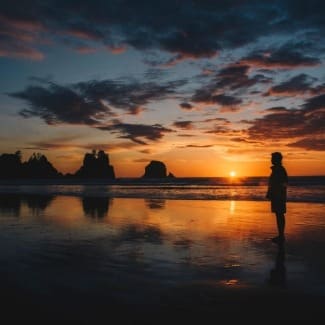
Whatever season you decide to visit Olympic National Park, you’ll want to wear comfortable, quick-dry clothing, and more layers depending on the season. You might pair a workout tank with a built-in sports bra with an athletic zip-up top, yoga pants, and waterproof hiking boots. Don’t forget ear warmers and hair ties if you need them!
Whether you’re traveling to Olympic NP in the summer or winter, you’ll want to wear comfortable, quick-dry clothing. You might choose a button-down with UV protection, quick-dry pants, and waterproof hiking boots. Don’t forget polarized sunglasses on the mountain!
Dressing for the Seasons in Olympic National Park
Spring – March, April, May
At the base of the mountain where it’s warmer, you can expect a low of 34℉ and a high of 50℉ in March, an average high of 57℉ and low of 37℉ in April, and an average low of 42℉ and high of 64℉ in May. Personally, I think cozy flannels are always a great spring layer for camping and hiking in Olympic NP.
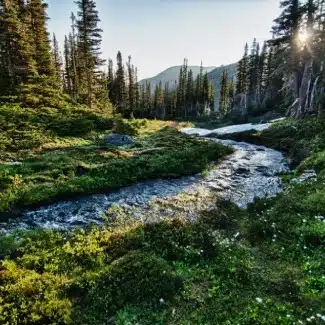
Summer – June, July, August
The summer months of July and August are the most popular months to visit the park, and you’ll find that most roads and trails are open. Even though the weather is warmer, you’ll want to prepare for thunderstorms, especially at higher elevations. Make sure you wear layers and an umbrella. June has an average high of 68℉ and a low of 46℉, and July warms up a bit more with average highs of 74℉ and a low of 50℉; August is just slightly warmer with a low of 51℉ and a high of 74℉. This varies some by elevation and area of the park.
Fall – September, October, November
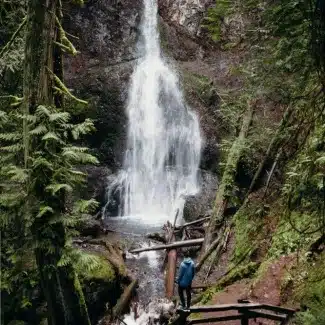
Winter – December, January, February
January is the coldest month in Olympic National Park, with lots of snow, especially at the park’s higher elevations. If you’re skiing at Hurricane Ridge during the winter, you can anticipate 30 to 35 feet of snow, so make sure to pack snow gear like snow pants and thermal underwear.
At lower elevations, temperatures in December are an average high of 42℉ and a low of 33℉, and you can expect the most rainfall in December, with averages of 17 rainy days out of the month. January won’t get above 40℉ and the low is 31℉. February warms to an average high of 45℉ and a low of 32℉.
Beach Days: Chacos are great for tide pool adventuring. You’ll want to make sure you have a solid windbreaker, either swimsuits or quick-dry clothing, and a quick-dry towel. The coast can get quite chilly!
Mountain Hiking: It’s colder up in the mountains, so you’ll want to wear layers, even if you’re visiting in the summer, as temperatures won’t get warmer than the 60s or 70s (℉) even at a lower elevation. Make sure you have a base layer and a cozy flannel that you can pair with a windproof coat.
What NOT to Bring to Olympic National Park
-
1.DON’T Bring Heavy Luggage
Hard-case suitcases might add needed weight in order to protect your gear, but try to limit the clothes and heavy items you bring—it’ll make getting around the vastness of Olympic NP easier.
-
2.DON’T Bring Lots of Cash
You won’t need to bring lots of cash to Olympic NP, especially out in the mountains. Keep your cards and a small amount of cash secure in a neck wallet, and leave the large amounts of cash at home.
-
3.DON’T Bring Breakable Items
I’ve had a glass french press that I thought was securely packed in my luggage break. Know that anything delicate you pack is at risk of breaking, and plan accordingly.
-
4.DON’T Bring Heavy Items
Everyone who backpacks and hikes knows—the weight of your pack adds up. Try to plan ahead and weigh your pack so that you don’t bring more than you can carry.
-
5.DON’T Bring Expensive Jewelry
Don’t risk losing valuable jewelry while exploring the park. Things can get easily lost on the trails or at the beach.
-
6.DON’T Bring Lots of Books
Even if you’re staying in a cabin and plan on catching up on reading in Olympic NP, more than one or two books will likely weigh you down. You can always bring a Kindle reader or read on the Kindle app on your phone.
FAQs about Visiting Olympic National Park
-
1. What time of year is best to visit Olympic National Park?
![What time of year is best to visit Olympic National Park?]()
The most popular time of year to visit Olympic NP is in the summer, July through August, and that’s when you’ll find the majority of the roads and hikes are open. The weather is lovely, generally 60 to 70℉, and you’ll just need to prepare for afternoon thunderstorms. The National Parks Service also has a newsletter with updates on seasonal activities, so you can plan ahead whatever time of year you’re planning on traveling to Olympic NP.
-
2. How do I get around Olympic NP?
Olympic National Park is located in Port Angeles, WA and people often fly into SEA (Seattle Airport) to get to Olympic. Starting at Hurricane Ridge Visitor Center (or one of the other ONP Visitor Centers) allows you to ask questions, take in the mountain ridge overlook, and plan more of your stops if you haven’t already. You’ll want to have a car to get around Olympic NP, but the 101 Highway will get you to most places around the park.
-
3. What’s the landscape like in Olympic NP?
![What’s the landscape like in Olympic NP?]()
The diverse ecosystems within Olympic NP are unlike any other National Park I have been to. There are not only incredible mountain hikes but coastlines like Ruby Beach and Shi Shi Beach and the majestic Hoh Rainforest. The landscape illustrates why people from WA often say, “Northwest is Best”.
-
4. What hikes in Olympic National Park are can’t-miss?
Olympic National Park covers almost one million acres, so there’s literally a lot of ground to cover. The National Parks Service divides trails up into four sections: North Coast Trails, South Coast Trails, Northside Trails, and Southside Trails. I would plan your itinerary around hikes in each section (if possible) or make a longer itinerary in one or two sections.
If you’re looking for a small, easy hike to start with near the Hurricane Ridge Visitor’s Center, I would recommend Hurricane Hill via Hurricane Ridge or Marymere Falls. Beyond that, it depends on the length of hike that’s ideal for you and the area of the park you’ll be in.
-
5. Should I prepare for bears in Olympic National Park?
![Should I prepare for bears in Olympic National Park?]()
Black bears live in Olympic National Park, and there have been a few incidents of aggressive bears throughout the years, although no injuries have been reported. The most important thing to remember is that when we hike, we are in their home. Make sure to keep food put away and give the bear space if you meet one on the trail. If a bear comes into camp, make noise in order to scare the bear away. Carry bear spray and ask park rangers any questions you may have.
-
6. What’s the quietest place in the US?
Hoh Rainforest is known as possibly the quietest place in the United States. Check out One Square Inch for information on enjoying and honoring the silence in this sanctuary.
-
7. Are there tide pools in Olympic National Park?
![Are there tide pools in Olympic National Park?]()
The tide pools along the beaches of Olympic NP are worth taking time to explore and enjoy. Starfish and sea anemones are everywhere, and they are more accessible than a lot of other areas I’ve been to with tide pools. As always, respect the wildlife and sea creatures as you enjoy the biodiversity.





